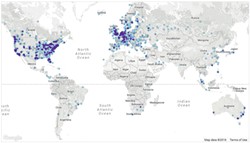[
{
"name": "Top Stories Video Pair",
"insertPoint": "7",
"component": "17087298",
"parentWrapperClass": "fdn-ads-inline-content-block",
"requiredCountToDisplay": "1"
}
]
When he encountered the Great Khan's paper money in China around 1260, explorer Marco Polo was astonished at the ready acceptance of what we now call "fiat money," i.e. currency established by the government (from Latin "fiat" = it shall be). He wrote, "All these pieces of paper are issued with as much solemnity and authority as if they were of pure gold or silver ... [a person can] transact all sales and purchases of goods by means of them just as well as if they were coins of pure gold." Until 1000 AD in China, virtually all money was "commodity money" like salt, gold and silver, valuable in its own right. Nowadays, we're so used to paper money that we hardly question its value, even though it's been only 51 years since the U.S. Treasury ceased minting silver coins once the metal content value exceeded the face value. A 90 percent silver, pre-1965 quarter is now worth about $1.40.
Since it's intrinsically worthless, fiat money depends on trusting one's government, which hasn't always worked. For instance, when the German Weimar Republic was threatened with the collapse of its monetary system in 1922, authorities reacted by printing more and more banknotes, leading to hyperinflation. Three years ago, the near-bankrupt government of Cyprus simply levied a 47.5 percent overnight "tax" on deposits held by the Bank of Cyprus. And when in 2008 our own government used tax dollars to bail out financial institutions deemed "too big to fail," we were reminded of the fragility of our system.
You don't have to be a libertarian to worry about government control over your money, which is why an increasing number of merchants and investors are turning to virtual money, such as Bitcoin, currently the largest such currency. As of 2 p.m. Monday, May 2, the total value of Bitcoin was exactly $6,912,905,203, when 15,498,050 Bitcoins, each worth $446.05, were in existence. In addition to such transparency, Bitcoin is inflation-proof; once 21 million Bitcoins are "mined" (scheduled for 2040), that's it. Twenty-one million, period.
If all this sounds Ponzi-weird to you, you're not alone. Bitcoin has attracted scores of opinion pieces warning of the danger of "crypto-currency" outside of government control or protection. Publications including Fortune, Business Insider and The Street have run more than 100 "death of Bitcoin" stories in the last five years, which hasn't stopped Bitcoin startups from raising more than $1 billion in that time. It probably helped that the U.S. Department of Justice pronounced it a "legal means of exchange."
Trying to explain Bitcoin, I can sympathize with Marco Polo describing paper money to his fellow Venetians. Here goes nothing: Bitcoin is a decentralized (no overarching authority), peer-to-peer (users transact directly, no middleman), virtual (no physical coinage), secure (cutting edge cryptography) currency system in which every transaction is recorded in a single, public, master registry: the "blockchain." The blockchain is stored simultaneously in more than 7,000 global databases (nodes). In a canny system by which new Bitcoins are "mined" at a predetermined rate, the operators of these Big Data nodes are paid in Bitcoins.
Although PayPal, Microsoft, Dell and Overstock (among many other large companies) accept Bitcoin, the jury is still out whether it will succeed. But if what is essentially green paper can work for 1,000 years without too great a problem, maybe Bitcoin is showing us the way to a government-free currency of the future.
Barry Evans ([email protected]) wonders when the Journal will start paying his huge freelance fee in Bitcoins.
Comments (2)
Showing 1-2 of 2
more from the author
-
A Brief History of Dildos
- Apr 11, 2024
-
Eclipse!
- Mar 28, 2024
-
The Little Drone that Could
- Mar 14, 2024
- More »
Latest in Field Notes
Readers also liked…
-
Trouble on the Line: The Reality Part 2
- Nov 3, 2022

































